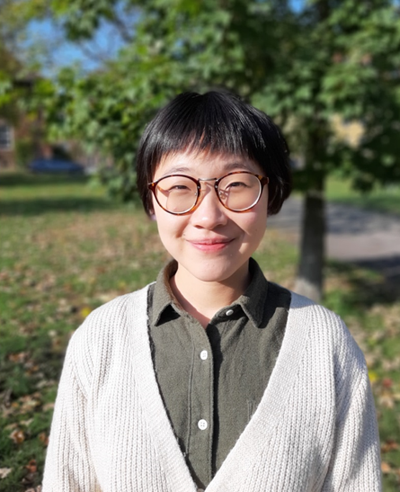Bioinspired crosslinking reactions occurring under physiological conditions for the synthesis of hydrogels for cell culture
Minye Jin is a PhD student in the Department Developmental BioEngineering. (Co)Promotors are prof.dr. H.B.J. Karperien and dr. J.I. Paez from the Faculty of Science & Technology.
 Hydrogels are hydrophilic polymer networks, which have been used extensively as artificial scaffolds in tissue engineering applications, especially in 3D cell culture. They exhibit some of the extracellular matrix (ECM) characteristics, such as porous three-dimensional structure, hydrophilicity, and mechanical and biochemical properties that can be adjusted on-demand. For hydrogel production, crosslinking is a critical process determining the material properties. In particular, covalent crosslinking strategies are mostly used due to the mechanical, thermal and chemical stability in the formed networks. The current available covalent crosslinking chemistries feature differences in their efficiency, reaction kinetics, commercial availability and price of reagents, hydrolytic stability of the newly formed covalent bonds, and biocompatibility. Each of these characteristics presents its advantages and limitations, which is highly dependent on the targeted application. In addition to the commonly used strategies, bioinspired crosslinking chemistries have received considerable attention as they have been optimized by nature to develop efficiently under biocompatible/mild conditions. Thus far, there remains a need to develop effective crosslinking strategies that could further expand the toolbox for biomaterials fabrication.
Hydrogels are hydrophilic polymer networks, which have been used extensively as artificial scaffolds in tissue engineering applications, especially in 3D cell culture. They exhibit some of the extracellular matrix (ECM) characteristics, such as porous three-dimensional structure, hydrophilicity, and mechanical and biochemical properties that can be adjusted on-demand. For hydrogel production, crosslinking is a critical process determining the material properties. In particular, covalent crosslinking strategies are mostly used due to the mechanical, thermal and chemical stability in the formed networks. The current available covalent crosslinking chemistries feature differences in their efficiency, reaction kinetics, commercial availability and price of reagents, hydrolytic stability of the newly formed covalent bonds, and biocompatibility. Each of these characteristics presents its advantages and limitations, which is highly dependent on the targeted application. In addition to the commonly used strategies, bioinspired crosslinking chemistries have received considerable attention as they have been optimized by nature to develop efficiently under biocompatible/mild conditions. Thus far, there remains a need to develop effective crosslinking strategies that could further expand the toolbox for biomaterials fabrication.
In this Thesis, a firefly luciferin-bioinspired ligation chemistry was applied as crosslinking method for the synthesis of hydrogel materials for 3D cell culture. A novel poly(ethylene glycol) (PEG)-based hydrogel platform has been developed, and the first comprehensive material characterization of this hydrogel system is provided. This hydrogel platform demonstrated convenient gelation time, homogeneous microstructure, tunable mechanics and degradability, and regulable biological properties, supporting cell spreading and proliferation. In combination with enzymatically-cleavable peptide crosslinkers, this crosslinking chemistry enables further tuning of degradability rates of the developed scaffolds.
In addition, various hydrogel platforms utilizing luciferin-bioinspired crosslinking chemistry (or close derived versions of it) have been investigated. These platforms encompass one with external redox-triggered gelation, another with reversible thioimidate-based dynamic covalent chemistry and a third one with tunable viscoelasticity through photo-initiated gelation. Altogether, the versatility of these hydrogel platforms allows for diverse molecular and network modifications, thereby extending possibilities for various biomedical applications.





